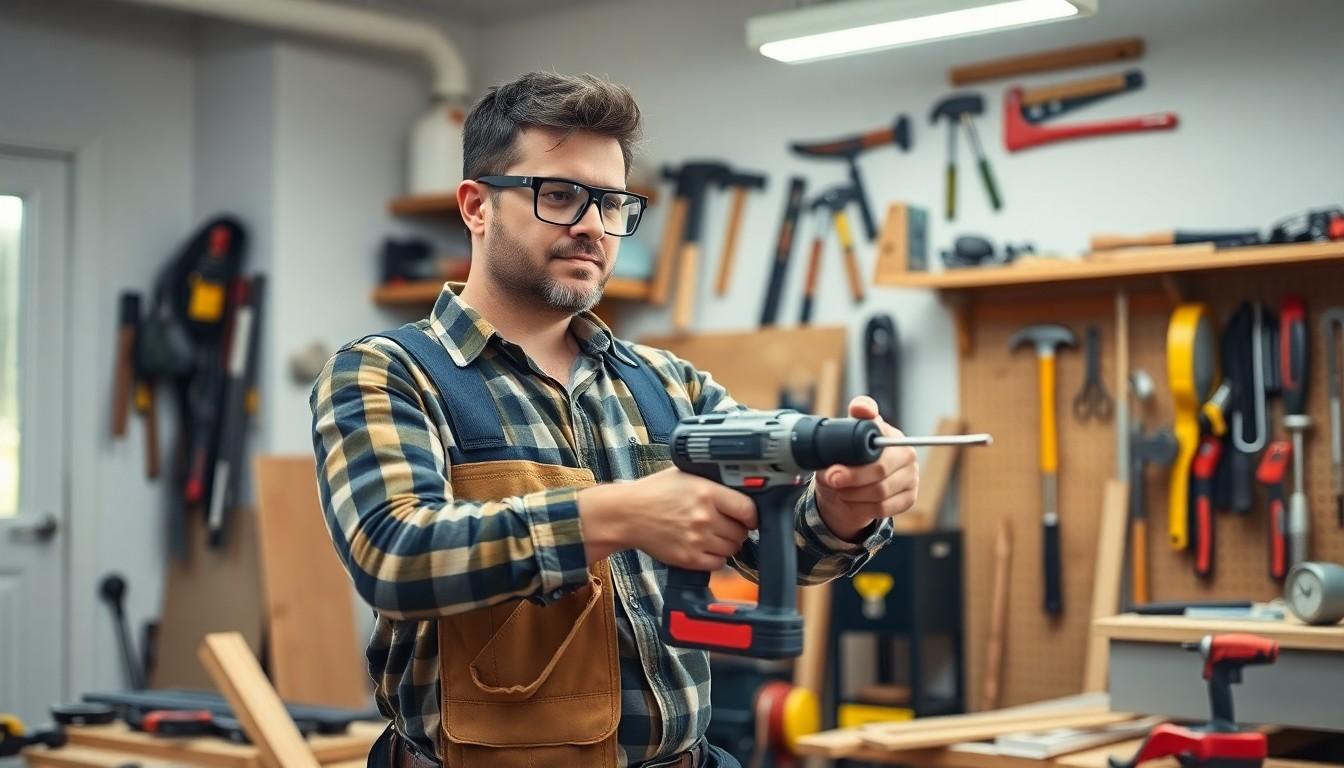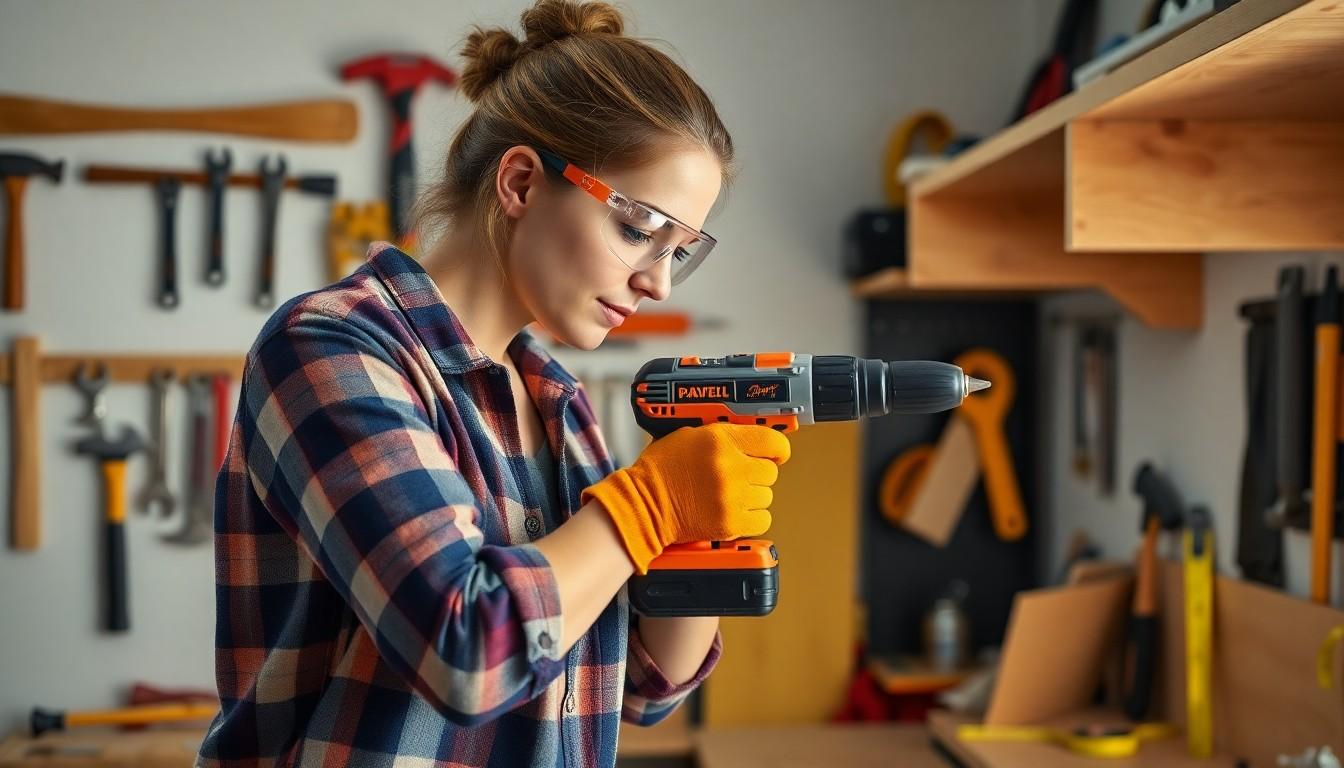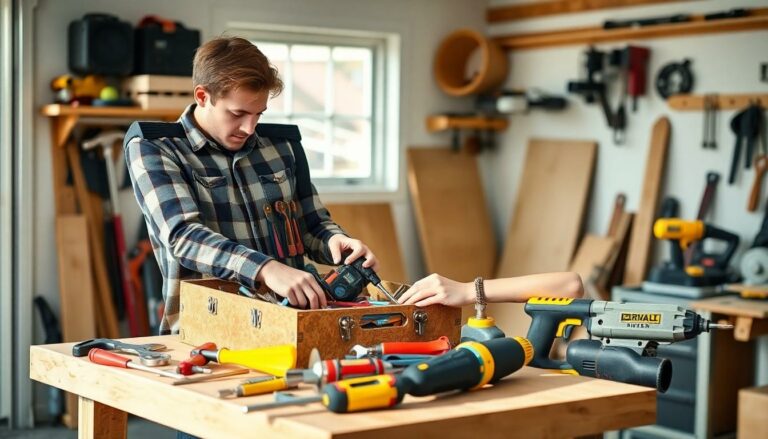Home improvement can feel like a daunting task, but with the right tools, it’s more like a fun DIY adventure. Imagine transforming your living space from drab to fab while wielding the power of a trusty drill or a magical sledgehammer. Whether it’s fixing that leaky faucet or finally tackling that long-overdue kitchen remodel, the right tools can make all the difference.
Table of Contents
ToggleOverview of Home Improvement Tools
Home improvement tools play a crucial role in successfully completing DIY projects. Essential tools include drills, saws, hammers, and wrenches, each serving specific tasks. A versatile power drill simplifies drilling holes and driving screws, making it an indispensable tool for various projects.
Saws, such as circular and jigsaws, cut through wood and other materials effectively. They facilitate building and remodeling tasks, from crafting furniture to constructing shelves. Hand tools, like wrenches and screwdrivers, assist in repairs and installations, ensuring tight fittings and secure placements.
Measuring tools, including tape measures and levels, ensure accuracy in all dimensions. Precise measurements contribute to the overall quality of home improvement projects. Safety gear, like goggles and gloves, protects users during renovations, minimizing the risk of injury.
Additionally, tool kits often provide a comprehensive set of essential tools for home improvement tasks. Having a reliable, organized tool kit promotes efficiency and convenience for any project. Quality tools, maintained regularly, enhance longevity and performance, making them valuable assets for homeowners.
Investing in high-quality home improvement tools not only facilitates significant enhancements around the house but also boosts confidence during each project. Exploring and understanding the specifications of various tools prepares individuals for successful DIY adventures. Mastery of these tools transforms daunting tasks into manageable projects, ultimately leading to a more enjoyable home improvement experience.
Types of Home Improvement Tools

Home improvement tools fall into various categories, each serving unique functions for DIY projects. Understanding these categories can simplify tasks and enhance productivity.
Hand Tools
Hand tools consist of essential items that don’t require electricity. Hammers play a crucial role in driving nails and assembling structures. Screwdrivers, available in various sizes, assist with different types of screws. Pliers grip, twist, and cut wires effectively. Wrenches, both adjustable and fixed, tighten or loosen nuts and bolts. Saws, like handsaws and coping saws, provide precision cutting for smaller projects. Each tool in this category adds efficiency to tasks, making them indispensable for anyone engaging in home improvement.
Power Tools
Power tools amplify productivity and ease during renovations. Drills are versatile devices vital for drilling holes and driving screws quickly. Circular saws make straight cuts in wood and other materials, essential for framing projects. Jigsaws enable intricate cuts for designs and shapes. Saws, including miter and table saws, enhance accuracy and speed in cutting tasks. Sanders smooth surfaces efficiently, preparing them for finishing. Investing in high-quality power tools not only speeds up projects but also ensures durability and reliability over time.
Measuring Tools
Measuring tools contribute to accuracy and precision in home improvement tasks. Tape measures provide flexible lengths for measuring spaces and materials. Levels ensure surfaces are even, preventing costly mistakes in installations. Squares assist in marking right angles, crucial for framing projects. Calipers measure internal and external dimensions with high precision. These tools help ensure that projects meet design specifications, leading to professional-quality results. Proper use of measuring tools enhances overall project success and saves time and resources.
Essential Tools for DIY Projects
Equipping oneself with essential tools significantly simplifies DIY projects. Homeowners benefit from having the right gear at their fingertips.
Basic Hand Tools Every Homeowner Needs
Pliers allow for gripping and twisting tasks, making them invaluable for various repairs. A durable hammer handles driving nails and tapping objects into place. Screwdrivers, available in both flathead and Phillips variations, assist in fastening and loosening screws easily. Wrenches, including adjustable types, tackle different nut sizes effectively. Utility knives come in handy for cutting materials with precision. Each of these tools plays a crucial role in completing everyday tasks efficiently.
Must-Have Power Tools for Home Improvement
Drills stand out as versatile power tools for creating holes and driving screws with ease. Circular saws cut through wood swiftly, perfect for framing or shelving projects. Jigsaws, on the other hand, excel at making intricate cuts, ideal for detailed work. Sanders help achieve smooth finishes on surfaces, enhancing the overall look of projects. A power sander enables quicker completion compared to manual methods. Investing in these power tools amplifies productivity during home improvement endeavors.
Safety Considerations When Using Tools
Safety is crucial when utilizing home improvement tools. Proper precautions ensure a secure working environment.
Personal Protective Equipment
Wearing personal protective equipment (PPE) significantly reduces injury risks. Safety goggles protect eyes from flying debris and dust. Hearing protection, such as earplugs or earmuffs, shields ears from loud power tools. Gloves help prevent cuts and abrasions while handling sharp objects. Respirators guard against inhaling harmful dust and vapors during projects. Steel-toed boots provide essential foot protection, especially when working with heavy materials. Utilizing these safety measures enhances project safety and ensures a focused work process.
Safe Tool Handling Practices
Using tools safely involves adhering to specific handling practices. Always read the user manual to understand proper tool operation. Keeping tools clean and well-maintained prevents malfunctions and accidents. Operating power tools with two hands increases control and stability. Unplugging devices when not in use avoids accidental starts. Ensuring workspaces remain organized reduces trip hazards and improves safety. Finally, using the right tool for the job minimizes the risk of injury and promotes efficiency. Prioritizing these practices fosters a safer DIY experience.
Maintenance of Home Improvement Tools
Maintaining home improvement tools ensures longevity and optimal performance. Regular care extends tool lifespan and enhances project quality.
Proper Cleaning Techniques
Cleaning tools after each use is essential. Remove dirt and debris with a damp cloth or brush. For rust-prone items like saws, apply a light coat of oil to prevent corrosion. Use soapy water to clean plastic and metal components, ensuring they remain functional. Avoid using abrasive materials that can scratch surfaces. When handling power tools, ensure to wipe down components that come into contact with dust and debris. Proper cleaning maintains tool efficiency and promotes safety.
Storage Solutions
Organizing tools in a dedicated space enhances accessibility and prolongs their life. Store hand tools in a labeled toolbox, keeping similar items together, which simplifies finding tools when needed. Wall-mounted racks or pegboards offer an efficient way to display tools visibly. For power tools, use sturdy cases to protect them from damage. Avoid leaving tools exposed to moisture, as it can lead to rust and degradation. A well-structured storage system promotes a safe and efficient working environment, reflecting a commitment to maintenance.
Equipping oneself with the right home improvement tools is essential for transforming any project into a successful endeavor. With a well-organized toolkit that includes both hand and power tools, anyone can tackle repairs and renovations with confidence. Prioritizing safety through protective gear and proper tool handling ensures a secure working environment.
Regular maintenance and thoughtful organization of tools not only enhance their longevity but also streamline the DIY process. By investing in quality tools and practicing good habits, homeowners can enjoy a more efficient and rewarding home improvement experience. Embracing these practices opens the door to endless possibilities in crafting a dream space.




